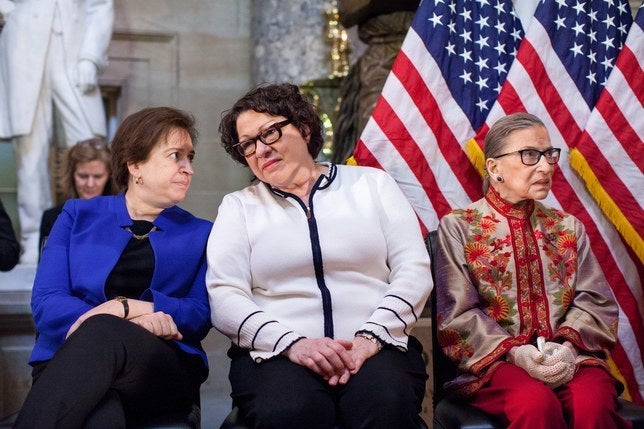For Glamour, by Maggie Mallon.

With just four of the 112 total justices who have served on the Supreme Court being women, it’s clear that the judicial branch has long been a male-dominated realm. Yes, three of those four women are currently sitting on the bench — yay, progress! — but if the way their male colleagues treat them is any indication, it’s going to be a long time before equal representation is truly achieved.
A recent study conducted by Northwestern Pritzker School of Law Professor Tonja Jacobi and Pritzker student Dylan Schweers revealed just how frequently the female justices are interrupted by men — and how this behavior reveals their general unwillingness to let the women on their Court make their case. The duo analyzed oral arguments from 1990, 2002, and 2015, when there were one, two, and three women on the court, respectively. In 1990, when Sandra Day O’Connor was the only female justice, 35.7 percent of interruptions occurred when she was speaking. In 2002, with O’Connor and Ruth Bader Ginsburg on the court, 45.3 of interruptions were directed at the two women on the court. And in 2015, when Ginsburg was joined by Sonia Sotomayor and Elena Kagan, 65.9 of interruptions happened as the three women made their oral arguments.
Interestingly enough, the women on the court actually speak less often and use fewer words when they make their argument (it’s unconfirmed if this a defense mechanism to cope with the inevitability of a male justice interrupting them). However, that doesn’t stop their male colleagues from interjecting at a much higher rate than they would for the other men sitting on the bench. Case in point: In 2015, Ginsburg was interrupted 11 times by Anthony Kennedy; Sotomayor was interrupted 15 times by Kennedy, 14 times by Samuel Alito, and 12 times by Chief Justice John Roberts; Kagan was interrupted over 10 times each by Kennedy, Alito, and Roberts. In contrast, only two of the men court were interrupted upwards of 10 times and the highest number of interruptions coming from one of the women was seven.
The researchers found that this wasn’t simply a matter of seniority, considering that Kagan and Sotomayor are the most junior ranking members of the Court. Though these two women were interrupted more frequently than the nearly 24-year-veteran RBG, Jacobi and Schweers determined that gender was “approximately 30 times more influential than seniority” when it came to interruptions.
Worse, this behavior even carries through to advocates who appear before the Supreme Court. These men show less deference for the women on the Court and interrupt the women regularly, even though Court protocol prohibits such behavior and the Chief Justice is expected to intervene when such a matter occurs.
“As Jacobi and Schweers note, these interruptions go beyond being unquestionably rude. Oral arguments are a crucial part of the judicial process and are often integral to shaping a case’s outcome.”
As Jacobi and Schweers note, these interruptions go beyond being unquestionably rude. Oral arguments are a crucial part of the judicial process and are often integral to shaping a case’s outcome.
“This pattern of gender disparity in interruptions could create a marked difference in the relative degree of influence between the male and female justices,” they wrote. “Furthermore, oral arguments serve other purposes, including: focusing the justices’ minds, helping them gather information to reach decisions as close as possible to their desired outcomes, and providing an opportunity to communicate and persuade their colleagues. When a justice is interrupted, her point is left unaddressed, and her ability to influence the outcome of a case or the framing of another justice’s reasoning is undermined.”
More from Glamour:

